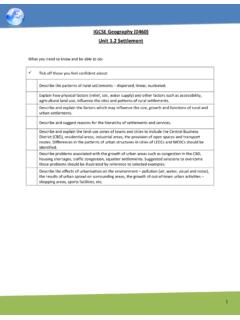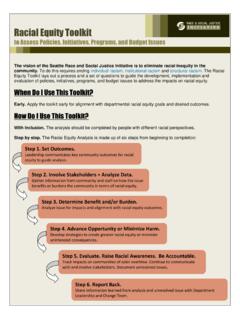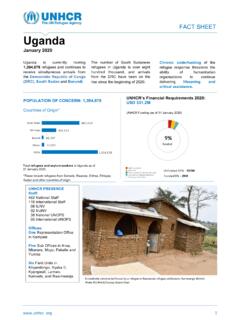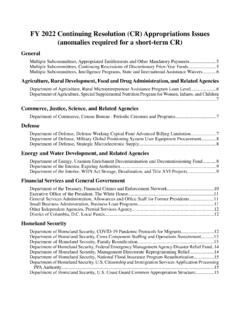Transcription of Implementing a community-based approach - UNHCR
1 |27|33 Implementinga community-basedapproachCommunities and cultures are not static;they constantly of refugees , internallydisplaced persons, and returneeshave social and cultural traditions,religious practices, economic activities,associations and networks, protection mechanisms and political structuresthat existed prior to displacement. Displacement disrupts many of thesefamiliar ways of life, but it can also be an opportunity for learning newskills and incorporating new knowledge, activities and structures intodaily life. Implementing a community-based approach during humanitar-ian crises involves mobilizing individuals and communities and support-ingthem in their decisions about how to cope with the upheaval,This section gives an overview of the different stages of the commu-nity-based approach , beginning with situation analysis, includingstakeholder analysis and participatory assessment, and planning.
2 It thenexplains the different aspects of community mobilization and empow-erment, from mapping leadership and management structures to com-munity-based action planning, monitoring and evaluation. It alsohighlights the need to identify individuals at heightened risk and toestablish individual case management systems based on work with 13:28 Page 27|28|A community-based approach in UNHCR Operations3re-establish community structures and ensure that protection andsolu-tions respect individual Situation analysisSituation analysis enables humanitarian workers and the com-munity to understandthe context of the displacement or crisis in order todetermine the most appropriate course of action,prioritize workand planoperationsto deliver protection effectively. It is a crucial step in results-based management as it informs project design and the formulation ofobjectives and anticipated results. Situation analysis inUNHCR is composed of three interlinkedphases: information analysis; stakeholder resourcesand capacity-map-ping; and participatoryassessment, to gain a common understandingofprotection risks, capacities and solutions.
3 These can lead to a participatoryplanning process to establish UNHCR Country Operation Plans, inter-agency humanitarian appeals or work plans, or community action analyses should be undertaken regularly, regardless of the stageof the operation. Representatives of community-based organizationsshould be involved in inter-agency and stakeholder planning is undertaken through a desk review ofexisting information, including data gathered about the population. It alsoinvolves identifying thedifferent stakeholders to learn about their inter-ests andpriorities, and mapping their activities, resources and expertise. Aparticipatory assessment is then conducted with the different members ofthe population to understand their protection risks, capacities and propos-als and to test the validityof the existing information and together, all actors should analyze the final results of the assess-ment, the protection risks, proposed solutions and resource implicationsin order to determine priorities, programmes and budgets and prepareaction Information analysisThis phase helps determine what is already known about the persons ofconcern and their situation by analyzing documentation and data.
4 It allowsCBA_Manual 13:28 Page 28|29|A community-based approach in UNHCR Operations3us to prepare for participatory assessments and consultations with a pro-tection is important toknow aboutthe community s culture and protectionmechanisms prior about thehost community and allother stakeholders should also be gathered. To identify potential protec-tion risks and those groups with specific needs, gather information on thenumber ofunaccompanied and separated children, single-parent-headedfamilies, single women, persons with disabilities, older persons andgrand-parent-headed households, and how women s and men s roles havechanged. Analysis of this information, which might reveal groups whoneed priority protection,including assistance, can then be shared with thecommunity and validated with the populations concerned during partici-patory assessments. UNHCR s Strengthening Protection CapacitiesFramework, which is a tool for identifying gaps in protection, can also helpstructure the followinginformation should beanalyzed:CountryOperation Plans, annual protection reports, standards and indi-cators, security and mission reports (on child protection, communityservice, gender, sexual and gender-based violence, and InspectorGeneral reports), inorder to identifyprotection incidents, securitychallenges and assistance needs; to highlight persistent problems andgaps.
5 And to identify community coping mechanisms and database and all other information related to the registration ofpersonsof concern, in order to understand the profile of the popula-tion by age, sex, family composition, ethnic/religious origins and and protection staff shouldensurethat data on groups with specific needs are regularly gathered andupdated, and that persons at heightened risk are identified and assessments and analyses, such as food basket-monitoringreports, joint WFP- UNHCR food assessments, health reports, includ-ing data from health-information systems, HIV/AIDS studies, envi-ronmental assessments, economic surveys andfeasibility studies forlivelihoods, in order to learn about the diet and purchasing power ofpeople in thelocal area, and about the impact of displacement on nat-ural 13:28 Page 29|30|A community-based approach in UNHCR Operations3 Studies of national legislation and provisions relevant to persons of con-cern from an age, gender and diversity perspective, in ordertounder-stand how and whether people of concern enjoy freedom ofmovement, equality,the right to work, access to services, and familyandchild reports and plans on national health, education and otherservices, tosee how they incorporate the needs of persons of concern,particularly in thecaseof internally displaced persons and is also important to review UN country plans to see how they incor-porate persons of concern and to advocate that they be included.
6 Political analysis documents reviewing the situation in the areas ofdis-placement and country of origin, reports from non-governmentalorganizations, universities, human rights organizations and othercivil associations, such as local women s groups, that provide analysesof the human rights situation, and ethnographic and of the area of origin and thearea of displacement. Note the proxim-ity to the border or conflict area, resources available and, inthe caseof urban populations, where people factors such as land availability, plot sizes and the locationof keyinfrastructure, natural resources, local markets, services and knownzones ofconflict, landmines, violence, exploitative practices and inse-curity, and specific places or routes that are known to present a dan-ger to persons of concern. This map can be used later in participatoryexercises with focus groups to stimulate discussion about protectionandrelated problems within the host area.
7 In urban areas, note thedistance to services, including the offices of UNHCR and its part-ners, and centres to which resources could be directed to better servepersons of reviewing existing information using an age, gender and diversityperspective, consider:32 The profile of the community, including capacities and skills, and who ismost at thecommunity is organized, its formal and informal structures andthe roles these play in community 13:28 Page 30|31|A community-based approach in UNHCR Operations3 The extent to which women, girls, boys and men of all ages and diversebackgrounds, includingthose with disabilities, participate incommunitymanagement and decision-making, and who might be excluded and mechanisms to support persons with disabilitiesand other groups withspecific needs, and identify those who are at height-ened available to people, such as land, tools, skills, and informal power relations between thedifferent community members: Whohas power over whom?
8 How is it exercised? To whose benefit?The services and facilities available to persons of concern withinthe hostcommunity and local interaction between the host population and persons of concern, andpoints of main protection challenges and thepossibilities for durable situation in the place of origin and the changes due to topics andindividuals should be the focus of the participatoryassessment phase. UNHCR / P. Benatar / 13:28 Page 31|32|A community-based approach in UNHCR analysisStakeholder analysis involves identifying all those individuals or groupsthat might be affected by a particular action and that therefore have a par-ticular interest in participating in the planning of activities or can influ-ence anoperation. Stakeholders can be both duty-bearers andrights-holders. Stakeholders include operational and Implementing part-ners, national and local authorities, UN agencies, members of the commu-Ten questions to ask when analyzing registrationdataDetermine the percentage of the population by sex, age group, andother factors, and consider: Is it the same as the local population?
9 Does it coincide with the datafrom the country of origin? Is there a higher-than-average percentage of women? Children?Older persons? Persons with disabilities? If one group, such as adult men or young children, seems under- orover-represented, find out why. Has the registration team been trained on how to identify and reg-ister groups with specific needs and persons at heightenedrisk? Have groups withspecific needs been registered in detail in coordi-nationwith community services? If not, why not and how will thisbe done? Have those responsible for registration understood the criteria forunaccompanied and separated children? Does the populationprofile indicate potential protection risks forany particular group? Who might beat heightened risk? Why?What immediate action isbeing taken toprotect these persons?Has a confidential, individualcase-management system been established? Do you have data on the leadership structure? Are any groups,espe-ciallyminorities, youth and women, not represented?
10 If so, why? How does the socio-economic status and ethnic, linguistic and reli-giouscomposition of the refugee population compare with that ofthe local host population?CBA_Manual 13:28 Page 32|33|A community-based approach in UNHCR Operations3nity, including community leaders and traditional chiefs, civil society(local NGOs, women s groups, human rights groups), school-board mem-bers, religious organizations, and host communities and their organiza-tions. We should document their level of influence, map their activitiesand work with them to plan among stakeholders isessential for establishinga community-based approach and reinforcingeach other s work. Some important stakeholders are:Governmentsofthe country of asylum and country of originGovernments of the country of asylum and country of origin have pri-mary responsibility for protecting refugees and IDPs and returnees,respectively. In practice, however, States vary in their ability or willing-ness to fulfil their obligations.

















